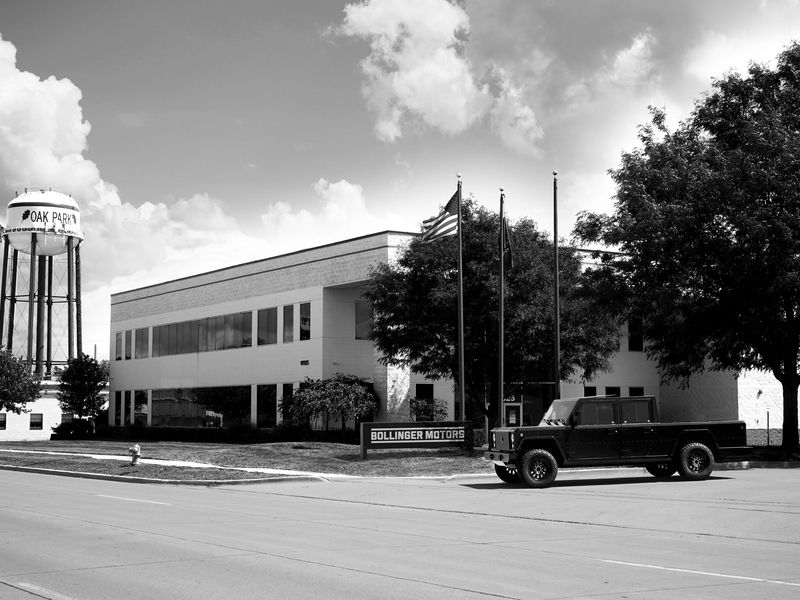
Robert Bollinger is aiming to break the jinx of 14925 W. Eleven Mile Road in the Detroit suburb of Oak Park.
The 36,600-square-foot building, constructed in 1996 and located about 3 miles north of Detroit’s northern city limits, is no stranger to pickups, electric vehicles and other automotive ventures.
But nothing that has emerged from its walls this century has met with much commercial success.
The building was once operated by ASC Inc. — the former American Sunroof Corp. — and the first production vehicle engineered there was the star-crossed 2004-06 Chevrolet SSR pickup with its novel retractable hardtop.
The first few SSRs were hand built at the Eleven Mile Road plant before production was transferred to GM’s Lansing Craft Centre in Michigan, which was used to assemble GM’s low-volume specialty vehicles such as the Buick Reatta and GM EV1.
GM expected to produce 13,000 SSRs a year but ended up selling only 24,000 of the $42,000 pickups over a painful three-year production run. ASC vacated the premises when the SSR fizzled. Not long after, in came a company called Azure Dynamics.
Armed with a contract from Ford Motor Co. to produce electric versions of the Transit Connect small van, Azure had hopes of selling 1,000 electric Transit Connects per year. But a $57,000 price tag and a 56-mile-per-charge range proved to be a commercially lethal combination. Fewer than 500 electric Transit Connects were built before Azure ran out of cash in March 2012.
The building sat empty for a time. Then a supplier that produced parts for automobile seats became the next tenant to pick up the keys to the glass front doors at 14925. That venture was bought out by seating company Adient in 2017.
The following year Bordrin New Energy Vehicle Corp., a Chinese startup that planned to produce two EVs, a crossover and a sedan, took up residence in the old ASC building. By some accounts, Bordrin was making good progress. Then trade tensions with China, consolidation among Chinese EV startups and COVID-19 hit. Bordrin’s demise came in June.
Bollinger Motors and its staff of around 40 engineers moved into 14925 last week after outgrowing cramped quarters in a gritty industrial park down the road in Ferndale, Mich.
Over the years, one of the occupants of 14925 painted over a multicolored silhouette of the SSR that was hand-painted high on the northern interior wall of the building. Just below where that ghostly SSR was once parked now sit early versions of Bollinger’s three vehicles — the B1 SUV, B2 pickup and a chassis cab intended for commercial buyers.
Next comes the production of engineering mules with product-intent parts for real-world testing. CEO Robert Bollinger told me this week he will have good news to report soon on securing funds to get the trucks into production, that he’s close to finalizing a deal with a contract manufacturer to build the trucks “in the Midwest,” and that he’s on track to deliver his first vehicles to customers late next year.
Bollinger doesn’t come across as superstitious, and he appears to care little about the building’s previous occupants and the ventures that didn’t succeed.
Bollinger admits that had he known how complex and difficult it is to design, develop, engineer and bring a vehicle to market, he probably would not have attempted the venture. Still, he says, he does feel good about the company’s prospects. Wall Street investors have lately embraced startups and EV companies such as Rivian, Nikola, Fisker and Workhorse. And consumer interest in electric trucks is surging just as Bollinger’s vehicle development reaches a critical point.
Speaking of other startups attempting electric trucks, Bollinger says: “Even though I hear about all that stuff and I am glad they are around because they create more vendors, I only care about us making our trucks.”
Unlike competitors, Bollinger vehicles are Class 3 trucks and must meet a different set of safety regulations that make them a bit less complex to engineer.
“I knew from the beginning I didn’t want to compete head-to-head with what I knew was coming out,” Bollinger said. “We’re comfortably unique in our Class 3 offerings. We’ve got that corner to ourselves.”
Paul Wilbur, CEO of ASC when the company developed the SSR, is familiar with the history of 14925 W. Eleven Mile Road. He spent many hours under the roof as engineers worked the bugs out of the pickup’s retractable hardtop and unique fender flares. And he’s met with Bollinger executives several times.
“So, the building has a bit of a hex on it,” Wilbur says with a chuckle as the list of former 14925 occupants is recalled. Wilbur, speaking in general about EV startups, says the cash demands to make it to market — even at the low volumes Bollinger plans — are astronomical and the odds are not good.
“It’s very hard, a nearly impossible task,” says Wilbur. “The scale and cost of getting anything going, even at small volumes, is so expensive, literally a billion-dollar proposition.”
But addressing the projects that were attempted at 14925, Wilbur says, “there was some really good work done there by some really talented people.”